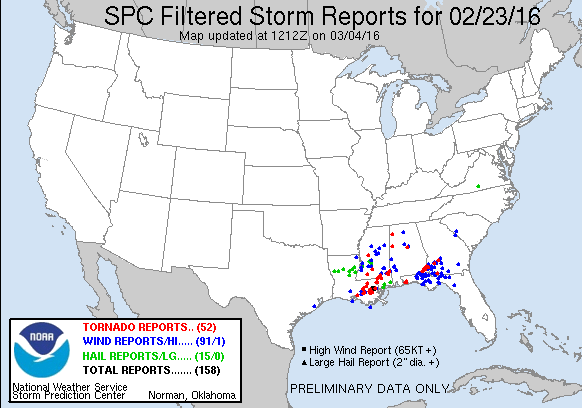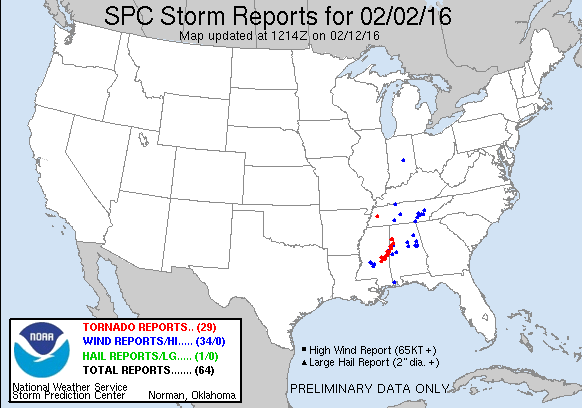Ah, the “thunder in February, frost in April” saying. Works every time, right?
Well, not quite.
This is an “old wives tale” that a lot of gardeners and farmers still use. And it is circulated with varying specificity. Some say that if there is any thunder in February, it will frost in April. Others that the day that you hear thunder in February, that on the same date in April will have a frost. While even some say that the thunder in February means a freeze in April! A freeze!
Other thunder-related superstitions? Sure, I pulled these from http://superstitiondictionary.com:
– It is said that Thunder in February is followed by thunder on the same date in May.
– Another superstition says that if it thunders in February, it will snow in May.
– The number of times it thunders in January tells the number of frosts April will have.
– If it thunders in December, there will be especially cold weather.
– And likewise, when you hear thunder in the winter, it is a precursor to very cold weather.
– The first thunder in spring is a sign that the winter is broken.
– Likewise, the first thunder in spring wakes up the snakes.
This stuff matters
No doubt! I know a lot of folks that experience storms in February and hold off planting until May because they are concerned about a frost, freeze or otherwise.
I have good news and bad news.
Good news: The claim of a frost on one day because of a storm on another day is false.
Bad news: It can still be frosty or freeze.
Really, this is a two-fold problem.
The first fold: We want to believe things we already know and we want to dismiss things that are new information challenging older information.
Neuroscientists have found that the human brain is good at learning brand new information. But once it has a piece of info, and new data comes along to challenge that information, our brains have a difficult time un-remembering the (now wrong) information and learning something new.
The Second fold: It is a situation of confirmation bias. People want it to be right, so people bend the truth to make it right. There was thunder on February 15, and, well it got down to 37 on the 17th of April. That is close enough. So it is valid.
But, it isn’t.
It is the same way with the Farmer’s Almanac forecasts. People want it to be right. When it calls for a week of cool weather in January, even if the temperature is average, people say it is right. Because January is, in general, a cooler month. The opposite is true in the summer. My favorite forecast from the Farmer’s Almanac for south Mississippi is “warm and humid, thunderstorms possible” for August.
August? Storms possible? Hot? Humid?
You don’t say!
My second favorite is during the first week of September when it says “Hurricane Threat” for the southeast.
Well, seeing as that is the peak of Hurricane Season, I suppose that is true. But that is like “predicting” the sun will rise tomorrow. Or that what you throw up will come back down. It isn’t much of a prediction if the outcome is rooted in scientific truth.
But I digress.
The fact is: Every February dating back to 2000 has featured a rumble of thunder in south Mississippi. And I would bet that every year prior to that as well. And regardless of thunder in February, there is always chance for a frost in April across a lot of the United States (save, perhaps the immediate Gulf Coast and most of Florida).
Every. Year.
Give me some data!
Let’s speak to the folks that think that specific days match up. Because that is going to be an easy one to compare. This post was written by someone in south Mississippi, so let’s figure it out for that region.
In 2018, there were plenty of days where there was thunder. It was a pretty active month. In fact, there were 19 days with thunder in South Mississippi. Not a single frost in April.
2017? Twelve days with thunder. No frosts in April.
In 2016, for Hattiesburg, there was severe weather on February 23rd.
On April 23rd? High of 81, low of 51. No frost. No freeze.
In fact in February of 2016, the Pine Belt endured multiple rounds of severe weather – weekly, and sometimes twice per week. Plenty of thunder. April’s lowest reading on the thermometer? It dipped to 39 degrees on April 3rd.
And before you say, “But Nick! There were storms on February 2nd! So it is right!”
Confirmation bias, again.
Remember, that 39 is not a frost, freeze or otherwise. It is just a bit cool. And it wasn’t the same day. And the coldest temperature the rest of the month was 42 on April 9th.
And there were no storms on February 9th.
But that is just one year. Let’s keep digging.
The previous year, 2015, was no different. Coolest day was April 5th. Low was 42. Meanwhile in February there were storms on first day of the month. And the 4th, 16th, 17th, 20th, and 21st, too.
Those same days in April?
| Date | Low | High | Precip |
| 1 | 59 | 82 | 0 |
| 4 | 48 | 74 | Trace |
| 16 | 67 | 80 | 0.59″ |
| 17 | 68 | 85 | 0.02″ |
| 20 | 52 | 78 | 0 |
| 21 | 50 | 78 | 0 |
Not convinced? Okay.
In 2014, the only day in April that was close to a frost was April 16th. The low was 35 degrees. On February 16th, 2014? It was 73 degrees and sunny. Storms didn’t arrive until the 20th.
In 2013, the coldest day was April 20th, it was 36 degrees for a morning low. On February 20th, it was 57 degrees with high clouds.
“But there was thunder on the 21st of February! See!”
Nope. That is an attempt to bend the facts using your own confirmation bias. Plus, a 36 degree low will rarely – if ever – produce a widespread frost.
Still not convinced?
Alrighty. I looked back through 100 years of data for the Pine Belt. All the way back to 1919.
Days with thunder were determined by days with rain and temperatures over 60 degrees. Days with frost were determined by any day with a low temperature of 35 or lower.
In all, there have been 629 days with thunder in South Mississippi during the last 100 years. Meanwhile, There have only been 50 frosts in April.
That should strike a cord immediately. If thunder equals frost, there should be 629 frosts for all 629 days with thunder.
Comparing the dates, there have only been 13 times where the day of thunder in February has matched with a day of frost in April.
That is only two-percent of the time.
So the saying, “Thunder in February, frost in April” is as accurate as someone who misses 98 out of 100 free throws.
The last April frost
The last widespread frost in April was just last year – April 3, 2021. On February 3, 2021? 28 for a low, 62 for a high. No precip. No thunder.
Before then? It had been a while. The last widespread April frost we had in South Mississippi was April 9th, 2000. It is the longest stretch of no-frosts during the last 100 years.
Turns out, that using my terms outlined above, that it also thundered on February 9th of 2000. So, it was one of the 13 matches.
But you can ask yourself, when was the last time before that, when the days matched up?
1987.
The time before that?
1975.
So since 1975, there have only been three days where it thundered in February and there was a frost in April.
So how safe is it to plant in April?
Well, since the year 2000, there has been two frosts in April. That is two day out of 600 April days. That is a 0.33-percent chance that any one day in April will have a frost. Or a 9.09-percent chance that any month has a frost.
I’m not suggesting that at the start of April you are always in the clear to plant. Because the chance for a frost in April has to do with shorter-term weather patterns and isn’t predictable on a seasonal scale yet.
But, according to math, leaning on the ‘I heard February thunder’ thing doesn’t mean anything.
Bottom Line
Generally east of the Rockies and south of the Great Lakes there are thunderstorms in February. And in those same places, come April, there is a chance that cold air moves south. With cooler-than-average conditions.
But the two are not connected.
Correlation does not equal causation. It isn’t that the two things can’t occur. It is just that, if a storm in February happens on the date date as a frost in April… it is happenstance.



